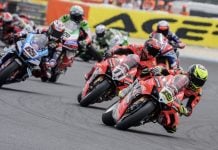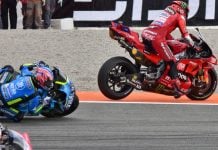FIRST PERSON/OPINION By Michael Gougis Jeremy Toye was at the airport, waiting for a flight to Northern California to compete in the Monterey Challenge at Mazda Raceway Laguna Seca, when his cell phone rang. It was one of the other racers who planned to race in the 10-lap sprint on July 23rd, the Friday morning of the Red Bull U.S. GP weekend. “He said, the purse has been pulled, and we’re not racing,” Toye recalled. The event had been promoted as a charity fundraiser event, with the winner of the race taking home $3000, second place getting $2000, third place being paid $1000 and fourth through 10th earning $500 each. But on Thursday, less than 24 hours before the race was to be flagged off, organizers announced that they would not pay any prize money. And only desperate last-minute negotiations allowed the race to go off at all. While Monterey Challenge promoter Jim Doyle insists that the race was sanctioned, AMA officials–the only ones who can sanction a race during an FIM event weekend–deny that the organization ever issued a sanction for the race. It was only when it became apparent that the race would take place anyway that AMA officials agreed to “observe the event from Race Control.” And AMA officials insist that the Monterey Challenge organizers were told nearly two weeks before the event that AMA would not sanction the race. The 11th-hour withdrawal of the purse, and the scramble to put on an unsanctioned race, didn’t have to happen. The rules for the operation of the MotoGP weekend are clear, as are the players who have specific roles to perform. As AMA spokesman Pete terHorst says, “It was difficult for AMA to understand how the promotion of the Monterey Challenge moved forward.” ***** MotoGP World Championship events are sanctioned by the FIM the Federation Internationale de Motocyclisme. FIM events in individual countries are organized in co-operation with the recognized national federation. In the United States, that body is the AMA. Simply put, the AMA (and other national federations) are charged with working with Dorna–the MotoGP promoters–in ensuring that the event is run to the standards set by the FIM for safety, organization and integrity. Two U.S entities were involved in the FIM MotoGP weekend at Laguna Seca–AMA Racing and AMA Pro Racing. In 2008, the AMA agreed to spin off its professional road racing operations to the newly formed Daytona Motorsports Group (DMG) of Daytona Beach, Florida. DMG, funded by NASCAR and International Speedway Corporation (ISC) billionaire Jim France and operating as AMA Pro Racing, became the sanctioning body for AMA-labeled professional road racing in the United States. AMA Racing, still operating from AMA headquarters in Ohio, offers sanctions for amateur events. When DMG purchased the right to operate as AMA Pro Racing, it became the only entity with the unilateral authority to sanction an AMA-labeled professional road race in the United States. As result of the contract between the AMA and DMG, AMA Racing cannot sanction any professional road race without the express permission and approval of AMA Pro Racing. AMA Racing is the host federation for the MotoGP event, meaning it and Dorna are responsible for its operation. FIM regulations for operating a MotoGP event clearly state that “events must not include any other races except for support races approved by the FIM and Dorna.” While the regulations do not appear to define when the weekend officially starts, according to that same FIM document, organizers must have liability insurance that goes into effect at 8:00 a.m. on the Wednesday prior to a race that happens on Sunday. So to connect the dots: For a MotoGP event to take place in the United States, the AMA is the host federation, acting with the FIM’s blessing and on the FIM’s behalf. Therefore, support races must be approved by the AMA. If it is an amateur event, a support race must have the approval of AMA Racing. If it is a professional event, a support race must also have the approval of AMA Pro Racing. All of this is long recognized and established. In 2009, Mazda Raceway Laguna Seca hosted an event called Club Auto Sport Uncorked. The event free from the noise regulations of a typical track day at Laguna Seca included a run-what-you-brung race for motorcycles. For $500, anyone could show up on any motorcycle and race. The event was not sanctioned by the AMA, but since it was a charity event with no purse and did not take place on an AMA or FIM race weekend, there was no need to seek an AMA sanction. (The event also ran without the usual soft barriers deployed at the racetrack, and was won by then-15-year-old Elena Myers.) Gill Campbell, CEO of Mazda Raceway Laguna Seca, says she saw the event as something to fill a gap on the MotoGP weekend. Neither the AMA support classes nor the MotoGP class were scheduled to be on the track on Friday morning (although AMA racers were begging for more track time at the event and AMA Pro officials now say they would have been happy to schedule additional practice sessions Friday morning). Campbell says only a small percentage of the tickets for the MotoGP weekend are sold to locals, and she anticipated that running a motorcycle-only version of the Uncorked race on Friday morning would help boost ticket sales among the local race community, and help sell more three-day passes to the event. Campbell enlisted the help of Jim Doyle to organize and promote the event. Yet Doyle and Laguna Seca didn’t get the AMA’s approval to hold the race an approval which was clearly required. Doyle says he met with AMA Pro Racing’s Dave McGrath at Infineon Raceway when the AMA Pro series ran there in May to outline the plans for the Monterey Challenge, and that McGrath promised to get back to him with a response but never did. McGrath did not return a pair of phone calls seeking comment. Not only did the organizers never receive the approval of AMA Pro Racing, but no one even asked AMA Racing for a sanction until three weeks before the event. Doyle and Campbell had sought a sanction for the race from other sanctioning bodies, including WERA. But whether anyone else agreed to sanction the event was a moot point–a support race on a MotoGP weekend requires FIM approval, and in the U.S., that means an AMA sanction. Finally, just before the July 4 holiday, Campbell sought a sanction from AMA Racing for the event, according to terHorst. But there was, literally, no way for AMA Racing to offer its approval. The Monterey Challenge was offering a purse. That made it a professional event. AMA Pro Racing wasn’t about to approve someone else’s professional event it has paid for the rights to operate professional road racing in the U.S. under the AMA name. And because the FIM required AMA Racing to be the host federation for the MotoGP event, the AMA’s name was all over the event. And there were other worries about the event, terHorst says. “The AMA communicated a number of concerns to Gill Campbell about the event,” terHorst says. “Specifically, they were sanctioning and operations, including race control, starter and assistant starter, grid services, technical control, timing and scoring. These operational functions have been provided by AMA Pro Racing in the past, and not the AMA. Without AMA sanctioning — which requires AMA Pro Racing concurrence — the AMA was unable to assist in any of these areas. “Further concerns were expressed about rules that would pertain to the race, guidelines regarding the specifications of the racebikes that would be on the track at the same time, protest or appeals procedures and medical insurance for the participants. We understood that the concept of the race originated as a charity event but there simply had to be a structure to assure the safety and integrity of the race.” On July 12, terHorst says, “Director of AMA Racing Joe Bromley notified Gill Campbell via e-mail that the AMA could not sanction the race or participate in any way.” Doyle says that he and Campbell sought, right up until Thursday, some way of holding the race without AMA approval and paying out the purse that had been promised. When it became crystal-clear on Thursday that a race for cash simply wasn’t going to be allowed something, frankly, that should have been clear long before the day before the race Doyle and the track pulled the purse. That satisfied the conflict with AMA Pro Racing. But racers, who in good faith had invested thousands of dollars in preparation for and travel to the event, were arriving for an event that still did not have approval to take place. Doyle and the track had, at the last minute, enlisted the help of Dorna officials for timing and scoring and other operational procedures. At that point, Doyle did not even have any flags (yellow, red, checkered, etc.) to use. (Doyle did, however, have a $5,000,000 insurance policy, including $10,000 of secondary medical insurance coverage for each participant.) Doyle insists that the AMA sanctioned the event. “Absolutely,” he told Roadracing World, when asked if he had acquired AMA approval. But AMA Racing–the amateur arm–says it could not sanction the event for more reasons than the restrictions imposed by its contract with DMG, operating as AMA Pro Racing. In fact, AMA Racing says it did not sanction the Monterey Challenge, and the race ran without a sanction of any kind. “The race promoter was not AMA-chartered, a pre-requisite for an AMA amateur sanction, and there was simply no time left for the AMA to conduct the due diligence required to vet a charter applicant,” terHorst says. “At the venue” Doyle “approached Kevin Crowther and Bill Cumbow of AMA Racing and inquired about an AMA sanction. They explained the AMA’s previously stated concerns and repeated that the AMA could not sanction the event. Because AMA Racing had a staff presence at the event, and because the AMA has an overriding interest in the safety of any event where it has a presence, AMA Racing agreed to observe the race from race control.” Campbell told Roadracing World that she didn’t know who had sanctioned the race. “I’ll be honest, I don’t know the answer to your question,” Campbell says. “I left off of any involvement prior to the event, everything else was then negotiated between Jim Doyle, Dorna, AMA, etc. I really don’t have an answer for you, I’m afraid.” ***** At the track, racers were told that they could have a refund and not race, or race and get half of their $400 entry fee back. The $200 kept by the Monterey Challenge, they were told, would go to the race’s charity the Wounded Warriors Project, a group assisting combat veterans. Toye raced and won. Six other racers pulled out of the event, Doyle says. Toye, Corey Sarros and Reno Karimian have retained Alessandro Assanti, an attorney and a racer in his own right, who says he will demand that the purse be paid or racers be reimbursed for their expenses. “I am hoping that Mr. Doyle will pay back every last dime to the racers that they spent to get there, including their entry fee (which was $400),” Assanti says. “This is wrong. They go up there, they risk their lives, they put on the show. I am a racer too, and I am sick and tired of this. I will go after every dime they spent to get up there and go race.” Doyle says he and the 17 volunteers who worked on the event made nothing. After covering expenses, Doyle says he plans to make a donation to Wounded Warriors for approximately $3000. Full refunds will be issued to the racers who pulled out, and $200 refunds will be issued to the 30 who raced, he says. Campbell concedes that the running of the Challenge got “very complicated. Because it’s an FIM weekend, it has to be an AMA-sanctioned event. To be able to get an AMA sanction, he could not put up a purse,” she says. When asked how this was not discovered until Thursday before the race, Campbell said, “You’d have to ask Jim (Doyle) that. It was the process of doing this the first time out, and it got very complicated. I am grateful to Jim Doyle for having put it all together.” Nor surprisingly, AMA officials were not pleased with the way events transpired. “The actions leading up to the Monterey Challenge put the AMA in a very difficult situation,” terHorst says. “AMA Racing, as the sole sanctioning body for AMA amateur racing, and AMA Pro Racing, as the sole sanctioning body and promoter of (AMA) professional racing, work together to guarantee that every race that bears the good name of the AMA meets a gold-level standard for safety and integrity. The AMA will continue to work diligently with AMA Pro Racing and others to ensure that these standards are not compromised in the future.”
What Was Up With The Monterey Challenge At Mazda Raceway Laguna Seca?
What Was Up With The Monterey Challenge At Mazda Raceway Laguna Seca?
© 2010, Roadracing World Publishing, Inc.






